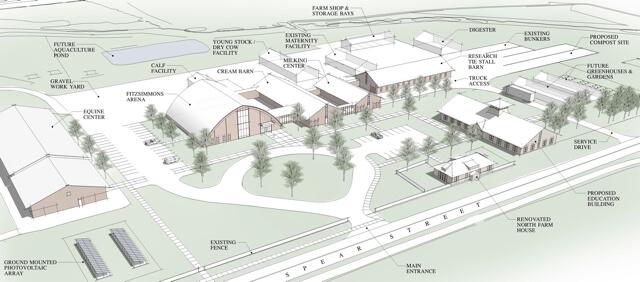Dream big and include everyone on idea gathering; these are the first steps to revitalizing the University of Vermont research farms.
Those steps are reflected in the latest “Blue Sky Vision” prospectus written by UVM College of Agriculture and Life Sciences (CALS) land-use committee. The 32-page document accompanies new blueprints by architects Smith, Alvarez, Sienkiewycz of Burlington, whose projects include the award-winning renovation of Williams Hall on campus.
UVM’s board of trustees approved a $4 million renovation in May 2009. Administrators, faculty, staff and stakeholders have been gathering information and updating the vision for at least six years.
“An important feature of the plans is that the new structures can be built in modular fashion, concentrating on the most important buildings first,” says Tom Vogelmann, dean of the College. “This ties nicely into our incremental fundraising goals.”
“Blue Sky recasts the roles of UVM’s farmlands and academic programs to meet modern challenges regarding the sustainability of Vermont agriculture,” says Vogelmann. “This comes at an opportune time to take advantage of the UVM’s transdisciplinary food systems spire. New facilities are essential for modern teaching and research that will allow students to learn about essential agricultural issues – energy efficiency, diversification, biological control, climate control and a systems approach to nutrient cycling and water quality.”
The basis for this proposal is an interconnected farm and food systems model that borrows from precedents we see in Hardwick, Montpelier and the Mad River Valley. The idea is to make every inch embody the latest agricultural research and education and manifest UVM’s expertise in food systems that spans all of its colleges and departments.
The plan calls for connecting research and education at the Miller Research Center and Horticulture Research Center, creating a whole system approach to sustainable farming whose methods span animals and plants to food products while converting wastes into resources and demonstrating best environmental practices.
Back in October 2009, the CALS advisory board pressed the College’s leadership to infuse the blueprints with “vision, energy, a champion, master plan, homage to the present while building for the future.” They called for the farms to be emblematic of all that UVM is doing for Vermont food systems, agriculture and life science research. They talked about it as the first visible introduction of UVM to anyone traveling the highway to Burlington.
“UVM Farms should be “the signature place that is iconic to the university; puts the University on the map – not a bigger footprint, a smarter one,” Mim Nelson told fellow CALS advisory board members last year. Nelson is Director of the John Hancock Research Center on Physical Activity, Nutrition and Obesity Prevention at Tuft University Friedman and author of 10 books.
“The Miller Research Center could become the embodiment of the food system spire,” echoed Bob Paquin, Vermont executive director of the USDA Farm Service Agency.
Current ideas include:
- Housing for about 200 cattle including the student-managed CREAM herd (Cooperative for Real Education in Agricultural Management) and additional lactating and young cattle and facilities for small ruminants.
- A compost facility to support a curriculum that is taught in only a handful of universities nationwide, yet is gaining influence as a sustainable practice.
- Moving the Center for Sustainable Agriculture and UVM Extension from their off-campus location to the UVM Farms.
- Expanding the Farmer Training Program, a new summer curriculum to the UVM Farms.
- Launching more summer course programs that take advantage of the growing season as prime time for on-farm education and research.
Also on the table are options for grass pasturing, organic soil management, biochar facility, kitchen and food lab, aquaculture pond and biofuel production facility, to name a few.
“The next steps are to obtain approval of the design concepts from University administration and Board of Trustees and then start fundraising, says Vogelmann. “I am eager to get this project going, so that we can integrate our academic programs and research into a modern food systems campus that will be invaluable for the entire University.”
